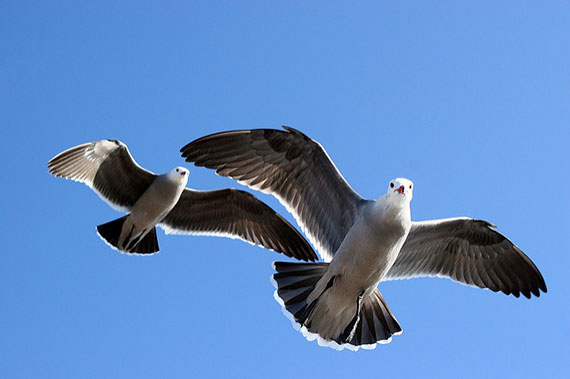To get good shots of animals and birds, you will have to learn to be quick in setting up and framing your shots. Waiting until you get out in the wilderness to learn these tricks is not a good idea. What I found to be very helpful was practicing on my cats and on birds in my yard or local parks. You learn to anticipate their behavior and react fast to get the good shots. Here are some tips on how to get the best shots of animals and birds in the wild (or at your local zoo).
Practice taking shots of moving targets. Learning how to pan moving targets will allow you to take dramatic photographs with a sense of speed.
Keep your camera handy and set up for unexpected encounters. Make sure you have fully charged camera batteries and plenty of film or memory.

Photo by sk8mama; ISO 400, f/7.1, 1/800-second exposure.
Before you go into an area, read up on what kinds of animals and birds are commonly found there. Learn all you can about these animals and birds. This will help you know where to look to find them and what kinds of behavior to expect.
Learn to walk and move quietly and practice freezing your position so that your presence is not startling or threatening to the animal.
Learn to be observant of everything around you using all your senses. With a little practice, you will gain the ability to be aware of small movements, unusual colors or sounds, even smells that can tip you off to the presence of an animal or bird even when they are well camouflaged. I cannot believe how many times I’ve watched people walk right by wildlife without noticing them. Hiking with an awareness of your surroundings enhances your experience immeasurably.

Photo by Flickr user Airwolfhound; ISO 250, f/5.6 aperture, 1/100 exposure.
In the wild, telephoto lenses are basically a must. This brings you in a little closer without scaring the animals. The use of a tripod is not always mandatory, if you have enough light you will be able to shoot at a fast shutter speed to eliminate shake. Some telephoto lens have vibration reduction technology but are considerably more expensive.
When you photograph animals and birds, make sure the focus is sharpest on their eyes.
Shoot small animals from a lower angle.

Photo by Alexandre Alacchi.
The best times of the day for viewing and photographing wildlife are early in the mornings and just before dark. This is when wildlife is usually most active and the light is the most dramatic.
Try to keep the sun at your back so that the light falls directly on your subject.
Using all these tips will help you improve your nature photography. The very most important thing is practice, practice, practice and don’t forget to enjoy yourself!
About the Author:
Roberta Hochreiter from womengophoto is an avid photographer, hiker, and backpacker with five years’ experience in nature photography.
Like This Article?
Don't Miss The Next One!
Join over 100,000 photographers of all experience levels who receive our free photography tips and articles to stay current:






Ome thing that I find people overlook in their quest for in your face wildlife shots is to back off sometimes and include the environment.
Oftentimes even though I have plenty of reach with my camera lens, I’ll still back off and show the surroundings.
I’ve had more positive comments on the footage I’ve shot from an African safari that included the surrounding environment than the in your face shots of the pride of lions that I brought home.
Another thing is don’t always go for the big prize. I’ve seen ridiculous bear jams at Yellowstone but was the only one that stopped to film a badger.
I’ve filmed a tallgrass prairie near my home for over a year now. Once I stopped looking for the “big prizes” of the prairie and really started looking, I was amazed at how much wildlife I discovered. By changing my thinking I discovered an incredible amount of wildlife that I would have passed over before.
Second the zoo suggestion. At our zoo, non-zoo wildlife comes for food. Thus, they tolerate people more than when in the wild. Only you know that you weren’t in the wild.
also, if you don’t have the cash to drop on a safari, use that telephoto lens to “fake” a safari at your local zoo! I do it all the time!
very useful article..